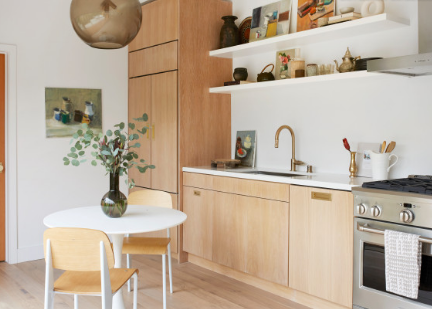If kitchen space is at a premium, could a single-wall layout be your solution? The single-wall kitchen has as little footprint as possible and, as the name suggests, integrates all the furniture and appliances in one line. Fewer cabinets means that this kitchen layout should cost less than others. With a well-planned design – where work areas can become too spread out in a small kitchen rather than a large kitchen – fewer cabinets also allow for an efficient workflow that puts everything within reach. Here’s how to make a single-wall kitchen work for you.

1. Embrace a Social Layout
While its small footprint may seem like a disadvantage at first, the single-wall kitchen has less encroachment on the adjoining living area than other layouts, freeing up more space for you to leave off the kitchen. The layout in the picture is a typical single-wall kitchen that complements modern open plan living.
Single-wall kitchens are often designed to allow only one person to cook at a time – a restriction that makes the kitchen safe but still easy for others to enter. It is important to keep this in mind to ensure that the design meets the needs and lifestyles of the users.

2. Plan an Efficient Design
Careful planning is important for any kitchen, but even more so when space is limited, as in this layout. Often, but not always, single-wall kitchens have a refrigerator at the far end of the kitchen. So that the sink is next to it, there is counter space on either side, and below is the dishwasher and pantry. Ovens and stovetops are usually located at their far ends. Similarly, there should be counter space on both sides of the stove so that you can safely place your food after cooking. More storage space will be available below.
Or, as long as they don’t block out the light source, you can place tall cabinets around the kitchen. This typically includes an oven with one side in a high enclosure and a refrigerator on the other.

3. Stick to Standard Cabinets
Above the lower cabinets, there is usually a row of taller cabinets, sometimes with a tall cabinet at one or both ends. Your exhaust fan and enclosure (if applicable) are also in this run. Cabinets can extend to the entire length of the wall.

4. Choose a Hybrid Shelf
Alternatively, you can use an exhaust fan or open shelving to break down the cabinets. A shelf on the wall to the left or right of the kitchen is another option, which is both decorative and functional.

5. Install the Bridge Upper Cabinet
Depending on the space available, another option is to introduce a series of bridge cabinets along the top of the upper cabinets. These usually have tall cabinets on both sides. In addition to the extra storage space, this creates a sinking effect for the upper cabinets through subtle changes in depth. The upper cabinet is about 14 inches deep and the upper cabinet is about 26 inches deep. The overall feel is a framed kitchen look, or a feature wall effect.
With this arrangement, it’s a good idea to store items that you don’t use frequently in a top cabinet and buy a folding ottoman for easy access. You can also match the color of your kitchen cabinets and walls to create a seamless look for your kitchen, dining room, or living space.

6. Make the Most of Your Storage Space
Storage is important for any kitchen, big or small, but it’s especially important for single-wall kitchens, which have fewer cabinets than other layouts.
Ensuring plenty of cupboard space is a must, but also consider whether there’s a chance that more storage space will be available elsewhere in the kitchen. In open spaces, it is popular to design furniture with the same finish outside the kitchen area to unify the space and create a fluid look.

7. Choose Appliances That Fit into Small Spaces
While a single-wall kitchen may be small, that doesn’t stop you from adding the appliances you want. Many modern kitchen appliances are specially designed for small spaces. For example, you can find an integrated compact dishwasher, compact oven, microwave, steam oven, and insulated drawers.
In an open layout, it is also worth choosing appliances wisely and making sure to choose a quieter model. This way, if your washing machine or exhaust fan is turned on, you will be much less opposed by the people watching TV or reading in the next space.

8. Add an Island
When planning a kitchen layout, it’s worth exploring if there’s room to add an island parallel to a single-wall kitchen. With careful planning, this will enhance the layout.
It also makes the single-wall layout suitable for larger spaces, since in effect, it reconfigures the room into a kitchen with the same functionality. While it depends on your space and how you want to use it, in general, the extra work surfaces and storage space introduced by the islands can be very beneficial.

9. Delineate Space
If the kitchen island doesn’t fit, you might consider adding a table that can be used both for dining and as an additional countertop. In addition to the obvious benefits of this, the table can also distinguish the kitchen from the living room, creating the feeling that they are two separate spaces.
Other ways to achieve this effect are through a breakfast bar with stools (perfect for entertaining guests) or by changing the floor between each area.

10. Highlight a Feature
You may want neat cabinetry for a clean, understated look. It’s a popular option that can also be used to highlight different aspects of the kitchen, like the stone feature wall shown in the picture, which is more eye-catching than the smallest white cabinetry.
Or maybe you want to make the single-wall kitchen itself the focal point. You can use bold colors in your cabinets to contrast them with the rest of the room. Alternatively, you can opt for a personalized shelving or a unique tailgate.
Regardless of your preferences, if you have a smaller space and are struggling to develop the best layout for it, a single-wall kitchen is worth considering. There’s so much more to this layout than meets the eye, and there are plenty of viable options to suit your needs.


